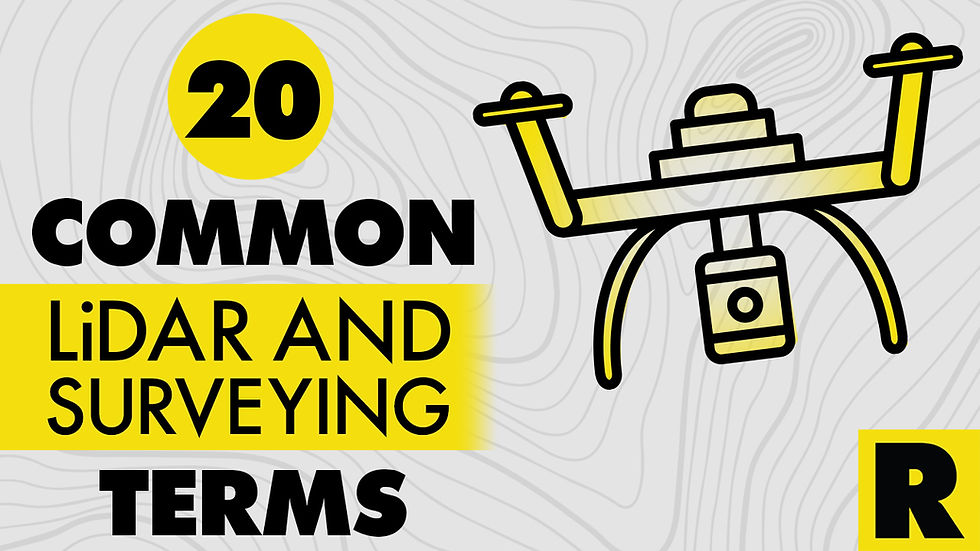Breaking Down 20 Common LiDAR and Surveying Terms
- Vincent Aurand
- Nov 3, 2022
- 3 min read
Updated: Aug 2, 2023

If you’re just getting started using LiDAR to create 3D models and maps, there is a ton of terminology to learn. Here's a glossary of the most helpful LiDAR and surveying terms you need to know.

Accuracy Report
A report detailing the accuracy of any LiDAR points in relation to known coordinates.

Bare Earth Model
A model of the area you are surveying that removes buildings, trees and any other surface objects. Bare earth models are generated in digital elevation models (DEMs), one of the key deliverables in ROCK Surveyor.
Breaklines
Lines that are marked to indicate a sharp break in elevation. This can include a curb, wall, ridge or stream. These lines improve the accuracy of contours. (Related: What are breaklines?)

Contour Lines Contour lines illustrate the difference in elevation at a set interval on a topographic map. Learn how to order contours through the ROCK Cloud here.

Digital Elevation Model (DEM)
A digital elevation model (DEM) is a visual depiction of the bare ground (bare earth) topographic surface of the Earth that removes trees, buildings or any other surface objects.
Digital Surface Model (DSM) or Digital Terrain Model (DTM
A digital surface model (DSM) or digital terrain model (DTM) captures the natural and built features on the Earth’s surface.
Flightline (or Trajectory)
A preprogrammed or manual drone flight and altitude path when capturing data.

Ground Control Points (GCPs) Marked points on the ground with known coordinates. GCPs are normally marked with an aerial target. These points serve as baselines to align physical points to the digital data produced by your LiDAR system. Learn about GCP best practices here. LAS The industry-standard file format that is designed for storing LiDAR point cloud data. LiDAR software, like ROCK Cloud, allows you to view and interact with LAS files. LiDAR LiDAR stands for Light Detection and Ranging. It is a remote sensing method of measuring ranges to the Earth using light in the form of a pulsed laser. Orthomosaic Mapping
An orthomosaic map is an aerial map made from many stitched-together still images. This map looks similar to what you would see in Google Maps.

Planimetrics / Line Work A planimetric map shows manmade and natural objects from an aerial view outlined with 2D or 3D features. This often includes parking lots, buildings, utilities, sidewalks, fences, roads, water features, vegetation and building footprints. To learn about planimetric maps in ROCK Cloud, click here. Point Cloud In LiDAR, a point cloud is a collection of individual points plotted in 3D space with X, Y and Z coordinates. Normally, point clouds are in LAS or LAZ file formats.
Point Density A ROCK R360 or R2A unit mounted to a drone can capture a high number of points per square foot or square meter on the ground through the canopy of trees and plants. Capturing high-density data is incredibly difficult to capture using traditional surveying methods. Pulse Rate The number of laser pulses per second. For example, the ROCK R360 emits up to 640,000 pulses per second. Return Number The total number of point returns from any given pulse. RMSE Believe it or not, LiDAR data isn’t perfect (although ours is pretty darn close). RMSE stands for root mean square error, which is the margin of error for accuracy in a LiDAR dataset. The ROCK R360 system has a range accuracy of 0.5 cm.
ROCK SLAM
ROCK SLAM (Simultaneous Localization Mapping) upgrades your existing ROCK hardware to allow you to walk around indoors, underneath trees, or anywhere you won't get good GPS in order to capture point cloud data. Learn more about ROCK SLAM here.

Topographic (Topo) Map A map that uses contour lines to show elevation on the Earth’s surface.
Volumetrics Volumetric surveys indicate how much material is being moved from a construction site. Learn how to measure volumetrics and stockpile data in the ROCK Cloud here.
Vegetation Management
Using drone LiDAR data to help specify danger zones across a transmission or distribution network. For example, ROCK Cloud provides you with a report that identifies problem areas across a transmission line at your set interval.
Now that you’re well-versed in the lingo, dive into the world of efficient and easy-to-use LiDAR hardware and software with ROCK Robotic. We are reimagining the way 3D data is captured and used.

Comments